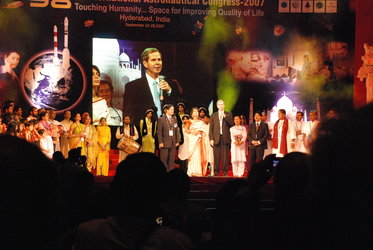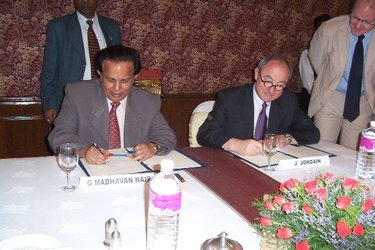Europe’s next ride to the Moon: Chandrayaan-1
Excitement is rising as ESA is in the final stages of preparation for the first collaborative space mission with the Indian Space Research Organisation (ISRO). Chandrayaan-1 will study the Moon in great detail and be the first Indian scientific mission leaving Earth’s vicinity.
Europe is supplying three instruments for the mission.
The Moon retains its fascination for planetary scientists and presents many mysteries still ripe for investigation. Chandrayaan, which means ‘journey to the Moon’ in Hindi, will study the Moon at many wavelengths from X-rays, visible, and near infrared to microwaves during its mission. It will orbit the Moon in a circular path, just 100 km above the lunar surface.

“The low orbit will give us really high resolution data,” says Detlef Koschny, ESA Chandrayaan Project Scientist. The principal mission objective is to map the surface of the Moon in unprecedented detail. At present the maps planetary scientists have show details of some 30-100 m across. Chandrayaan will produce maps with a resolution of between 5 and 10 m across the whole surface of the Moon. “We aim to have this in two years,” says Koschny.
Building on the experience gained with SMART-1, Europe’s first mission to the Moon, which was launched in September 2003 and concluded its work three years later, ESA is assisting ISRO with operations, data handling and flight dynamics. ESA is also coordinating the provision of three European instruments.
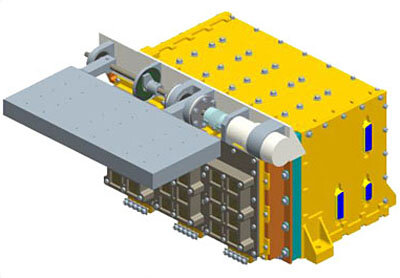
The Compact Imaging X-ray Spectrometer (CIXS) will carry out high-quality, low-energy (soft) X-ray spectroscopic mapping of the Moon. The Infrared Spectrometer, known as SIR-2, will observe the chemical composition of the Moon’s crust and mantle. Both of these instruments were flown on SMART-1 and have been upgraded and rebuilt for Chandrayaan-1. They will continue the work on surface composition started by the original instruments.

The third European contribution is the Sub-keV Atom Reflecting Analyser (SARA). Derived from the ASPERA (energetic neutral atoms analyser) instruments, flown on Mars Express and Venus Express, it will be the first lunar experiment dedicated to direct studies of the interaction between electrically charged particles and the surface of the Moon.
With no atmosphere, the Moon’s surface is constantly bombarded by the wind of particles released by the Sun. SARA will monitor these interactions and use them to image the Moon’s surface composition, study surface magnetic anomalies and study the gases released from the lunar surface by the collision of the solar particles.
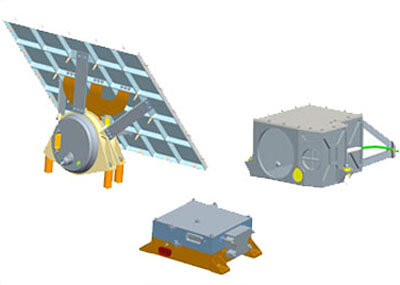
All European instruments are nearing completion and will be delivered to ISRO soon.
The low orbit means that these instruments, all of which rely on collecting the energy or particles emitted by the lunar surface, will work better. “Being closer to the surface means that the signal received from the surface will be stronger. This is good for global mapping,” says Christian Erd, ESA Chandrayaan Project Manager.
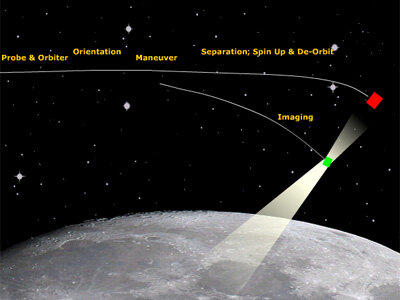
Apart from these European instruments, Chandrayaan-1 will carry another eight science instruments. They include a 29 kg landing probe (MIP), which will be dropped onto the Moon’s surface at the beginning of the mission to conduct investigations.
Chandrayaan-1 is scheduled to launch in April 2008 from Sriharikota, India. It will be carried into space by a Polar Satellite Launch Vehicle (PSLV) and placed on a five and a half day cruise to the Moon. It will then take two weeks of manoeuvres to fit into its operational orbit.
In addition to the great science it will address, Chandrayaan-1 will be a stepping-stone to future missions to other bodies, as well as to the Moon. For example, ESA’s BepiColombo mission to Mercury will carry a replica of SARA’s sensor subsystem, allowing the results from the two celestial bodies to be compared directly.
For more information:

Detlef Koschny, ESA Chandrayaan-1 Project Scientist
Email: Detlef.Koschny @ esa.int
Christian Erd, ESA Chandrayaan-1 Project Manager
Email: Christian.Erd @ esa.int







